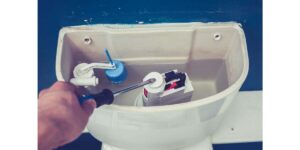Noisy toilets can be more than just an annoyance – they can also indicate a severe problem.
Common causes of toilet noise include leaks in the bowl or tank, a faulty flapper valve, a leaky fill valve, a cracked flush valve, a loose flush handle, loose tank bolts, a clogged vent stack, or issues with the water supply valve.
This post will explore these causes, show you how to identify the problem and provide step-by-step instructions for each fix.
We’ll also give you tips on maintaining a quiet toilet and when to call a professional plumber.
Causes of a Noisy Toilet:
Water leaks in the bowl or tank are a prevalent cause of a noisy toilet.
These leaks can happen due to a malfunctioning flapper valve, a leaky fill valve, or a cracked flush valve.
Other common reasons for toilet noise include:
- A loose flush handle.
- Loose tank bolts.
- A clogged vent stack.
- Issues with the water supply valve.
It’s essential to check for loose parts, such as the jamb nut holding the tank’s supply line.
If it is loose, use an adjustable wrench to tighten the nut, but be cautious as the nut and fitting are likely made of nylon and can strip when over-tightened.
Identifying the Cause of a Noisy Toilet
To begin repairing a noisy toilet, it is crucial to pinpoint the noise source.
This can be accomplished by examining the flapper, fill, and the flush valve.
Start the process by flushing the toilet and observing the water level in the tank. If it drops rapidly, the flapper valve is most likely the issue.
To check the fill valve, inspect for water trickling into the bowl. If you notice water, the fill valve is likely the culprit.
Lastly, inspect the flush valve for cracks or damage. If any are found, the flush valve is likely the noise source.
Fixing a Noisy Toilet
Once the cause of the noise has been identified, it’s time to take action.
To fix a faulty flapper valve, adjust the chain length so that it closes more securely.
If the fill valve leaks, turn off the water supply valve, remove the old valve, and replace it with a new one. The exact process applies to replacing a cracked or damaged flush valve.
In addition, check for any loose hardware and use an adjustable wrench to tighten it. Loose tank bolts can create a knocking sound.
Maintaining a Quiet Toilet
To ensure a quiet toilet:
- Inspect the water supply valve, tank ball, wax ring, and tank-to-bowl gasket for wear or damage.
- Check the adjustment screw and flush lever for proper function, and clean the refill tube and overflow pipe.
- Keep the float level and water level optimal.
- Replace the diaphragm or inlet valve if they are worn or damaged.
To prevent leaks, use silicone sealant and plumber’s putty for a secure seal and apply Teflon tape.
Tools and Materials
To fix a noisy toilet, you will require basic tools such as an adjustable wrench, pipe wrench, plunger, snake, drain cleaner, bucket, rags, gloves, and mask.
Before the repair, check if the jamb nut holding the tank’s supply line is loose. If it is, use an adjustable wrench to tighten it, but do it cautiously.
Troubleshooting
Troubleshooting a noisy toilet can be difficult if the cause of the noise is not immediately apparent.
Common issues leading to a noisy toilet include a worn tank-to-bowl gasket, a misaligned float, or a clogged overflow pipe.
To address these issues, you may need to inspect the gasket for wear or damage, adjust the float level, or clear any blockages from the overflow pipe.
Also, check the jamb nut holding the supply line to the tank, as it can be loose and cause noise.
Prevention
To avoid future noise problems, it’s crucial to frequently inspect the water supply valve, flapper valve, and fill valve for any leaks and maintain the cleanliness of the toilet bowl, tank, and vent stack.
Also, it’s essential to check the jamb nut that holds the tank’s supply line and ensure it’s not loose.
Use an adjustable wrench to tighten the nut snugly, being cautious not to over-tighten it as it can strip the nut and fitting.
Professional Plumbing
When faced with a problem that exceeds your skillset or knowledge, you should call a professional plumber for assistance.
Attempting to fix an issue you need help with can lead to further damage and costly repairs.
Trusting a professional to handle the situation ensures the job is done correctly and efficiently.
Safety Measures
Taking safety precautions when repairing a toilet is crucial. Turning off the water supply valve, wearing gloves, and wearing a mask.
One important safety measure to remember is to be cautious when tightening nuts and bolts to prevent cracking the porcelain tank.
Also, it is a good idea to familiarize yourself with the location of the main shut-off valve in case of an emergency.
Conclusion
Following these simple steps, you can repair and prevent noisy toilets and enjoy a peaceful home.
It’s important to always turn off the water supply valve before making any repairs and to proceed carefully.
Tighten the jamb nut that holds the supply line to the tank using an adjustable wrench.
Remember that a noisy toilet can be a sign of a bigger problem.
By addressing the issue promptly, you can prevent further damage and save yourself the hassle and expense of major repairs.
If in doubt, consult a professional plumber.




